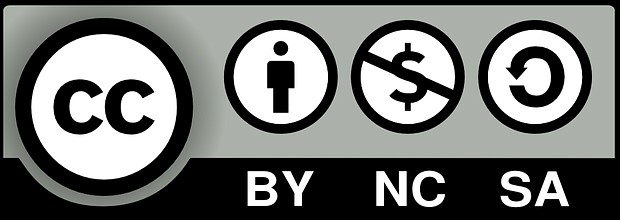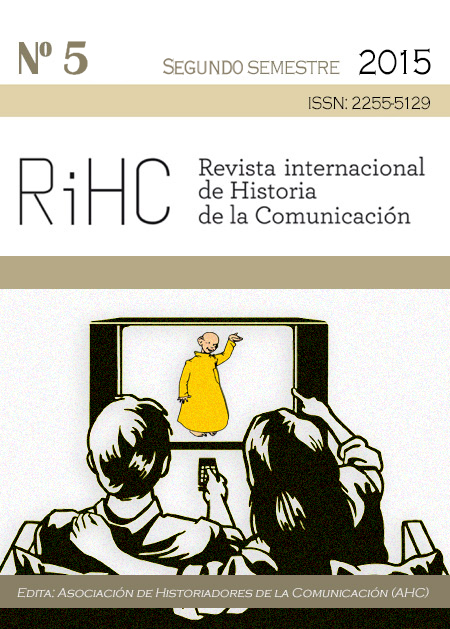Amarillismo e infoentretenimiento en la información televisiva sobre la crisis económica: el caso de Cuatro TV (2012)
DOI:
https://doi.org/10.12795/RiHC.2015.i05.05Palabras clave:
Televisión, crisis económica, sensacionalismo, infoentretenimiento, interés humano, personalizaciónResumen
Este artículo mide el impacto del infoentretenimiento y el amarillismo televisivo en las noticias sobre la crisis económica emitidas por Cuatro TV entre abril y junio de 2012. Para ello aplica un análisis de contenido a una selección aleatoria de noticias (n=159) en el que se consideran las siguientes variables: piezas emitidas sobre la crisis, duración de las mismas, posición que ocupan en la escaleta de emisión, encuadre aplicado en las mismas y tipo de fuentes que aparecen en las informaciones. Se concluye que el principal rasgo sensacionalista presente en estas noticias es la preferencia por fuentes de tipo personal e individual, mientras que la adopción del enfoque del interés humano es secundario.
Descargas
Citas
ABEL, A. D., & BARTHEL, M. (2013). “Appropriation of Mainstream News: How Saturday Night Live Changed the Political Discussion”. Critical Studies in Media Communication, 30 (1), 1-16.
ARRESE, Á., & VARA-MIGUEL, A. (2014). “Alarma y alarmismo: medios de comunicación y crisis económica”. Estudios sobre el Mensaje Periodístico,20 (2), 933-851.
BELL, C. V., & ENTMAN, R. M. (2011). “The media's role in America's exceptional politics of inequality”. The International Journal of Press/Politics, 16 (4), 548- 572.
BERROCAL GONZALO, S. REDONDO GARCÍA, M., MARTÍN JIMÉNEZ, V. & CAMPOS DOMÍNGUEZ, E. (2014). “La presencia del infoentretenimiento en los canales generalistas de la TDT española”. Revista Latina de Comunicación Social [en línea], 69, 85- 103. http://www.revistalatinacs.org/069/paper/1002_UVa/05_Be.html (12-6- 2016)
BLOOD, D. J. & PHILLIPS, P. C. B. (1995). “Recession headline news, consumer sentiment, the state of the economy and presidential popularity. A time-series analysis 1989-1993”. International journal of public opinion, 7 (1), 1-22
BOOMGAARDEN, H. G., VAN SPANJE, K., VLIEGENTHART, R., & DE VREESE, C. H. (2011). “Covering the crisis: Media coverage of the economic crisis and citizens’ economic expectations”. Acta Politica, 46 (4), 353-379.
BOUKES, M., & BOOMGAARDEN, H. G. (2014). “Soft News With Hard Consequences? Introducing a Nuanced Measure of Soft Versus Hard News Exposure and Its Relationship With Political Cynicism”. Communication Research, 42 (5), 701-731
BRANTS, K. (1998). “Who's afraid of infotainment?”. European Journal of Communication, 13 (3), 315-335.
CANEL, M. J. & INNERARITY, C. (2000).“La campaña electoral en la television”. En: A. Martínez y M. Méndez (eds). Las elecciones al Parlamento Europeo, Valencia: Tirant lo Blanch, 171-190
CALVO GUTIÉRREZ, E. (2011). “La supervivencia del gran periodismo financiero”. Fonseca Journal of Communication, 2, 55-70
DEL MORAL, J., QUESADA, M., SÁNCHEZ, J., LEÓN, B. & FERNÁNDEZ, A. (2007). El análisis de la información televisiva: hacia una medida de la calidad periodística. Madrid: CIE Dossat.
DÍAZ-CAMPO, J., & SEGADO-BOJ, F.(2015). “Journalism ethics in a digital environment: How journalistic codes of ethics have been adapted to the Internet and ICTs in countries around the world”. Telematics and Informatics,32 (4), 735-744.
DÍAZ ROJO, J. A. (2009). Los valores noticiosos como práctica discursiva periodística. Espéculo: Revista de Estudios Literarios [en línea], (41), 95. http://pendientedemigracion.ucm.es/info/especulo/numero41/valonoti.html (15-07-2015)
GARCÍA AVILÉS, J. A. (2007). “El infoentretenimiento en los informativos líderes de audiencia en la Unión Europea”. Anàlisi, 35, 47-63.
GARCÍA REDONDO, M. & CAMPOS-DOMÍNGUEZ, E (2015). “Implicaciones éticas del infoentretenimiento televisivo”. Comunicació: Revista de Recerca i d’Anàlisi, 32 (1), 73-89.
GOIDEL, R. K. & LANGLEY, R. E. (1995). “Media coverage of the economy and aggregate economic evaluations. Uncovering evidence of indirect media effects”. Political Research Quarterly, 48 (2), 313-328.
GOLD, J., PEDRANA, A. E.; SACKS-DAVIS, R., HELLARD, M. E.; CHANG, S., HOWARD, S., KEOGH, L., HOCKING, J. S.; STOOVE, M. A. (2011). “A systematic examination of the use of online social networking sites for sexual health promotion” [en línea]. BMC Public Health, 11. http://www.biomedcentral.com/content/pdf/1471-2458- 11-583.pdf (12-6- 2015)
HENDRICKS VETTEHEN, P., NUIJTEN, K., & BEENTJES, J. (2005). “News in an age of competition: The case of sensationalism in Dutch television news, 1995–2001”. Journal of Broadcasting & Electronic Media, 49 (3), 282-295.
HENDRICKS VETTEHEN, P., NUIJTEN, K., & PEETERS, A. (2008). “Explaining effects of sensationalism on liking of television news stories: The role of emotional arousal”. Communication Research, 35 (3), 319-338.
HOLTZ-BACHA, C., & NORRIS, P. (2001). “To entertain, inform and educate: Still the role of public television”. Political Communication, 18 (2), 123-140.
KLEEMANS, M., & HENDRIKS VETTEHEN, P. (2009). Sensationalism in television news: A review. En Konig, R. P., Nelissen, P. W. M. & Huysmans, F. J. M. (Eds.), Meaningful media: Communication research on the social construction of reality. Nijmegen: Tandem Felix, 226-243
JACKSON, D. (2011). “Strategic news frames and public policy debates: Press and television news coverage of the euro in the UK”. Communications – European Journal of Communication Research, 36 (2), 169-193.
MARÍN LLADÓ, C. M. (2012). “La pérdida de objetividad en las noticias de los programas de infoentretenimiento en televisión”. AdComunica, (4), 81-98.
MARTÍNEZ FERNÁNDEZ, V. A., JUANATEY BOGA, Ó., COSTA SÁNCHEZ, C. (2012). “Agenda setting y crisis económica: Influencia de la prensa en el comportamiento de consumo y ahorro”. Estudios sobre el mensaje periodístico, 18 (1), 147-156.
NGUYEN, A. (2012). “The effect of soft news on public attachment to the news: Is ‘infotainment’ good for democracy?” Journalism Studies, 13 (5-6), 706-717.
ORTELLS-BADENES, S. (2014). “Los criterios de noticiabilidad periodística en los programas de infoentretenimiento”. Textual & Visual Media, 7, 2014, 207-220.
PAZ, M. A. & MONTERO, J. (2011). “Las profecías son noticia. El uso del futuro en la información televisiva española sobre la crisis de Irak”. Comunicación y Sociedad, 23 (1), 153-174.
REINEMANN, C., STANYER, J., SCHERR, S., & LEGNANTE, G. (2012). “Hard and soft news: A review of concepts, operationalizations and key findings”. Journalism, 13 (2), 221-239.
SCHIFFERES, S., & COULTER, S. (2013). “Downloading disaster: BBC news online coverage of the global financial crisis”. Journalism, 14 (2), 228-252.
SCHWALBE, C. B., SILCOCK, W., & KEITH, S. (2008). Visual Framing of the Early Weeks of the U.S.-Led Invasion of Iraq: Applying the Master War Narrative to Electronic and Print Images. Journal of Broadcasting & Electronic Media, 52 (3), 448–465.
SOROKA, S. N. (2006).” Good news and bad news: Asymmetric responses to economic information”. Journal of Politics, 68 (2), 372-385.
THUSSU, D. K. (2007). News as entertainment. The rise of global infotainment. Londres: Sage.
VALKENBURG, P., SEMETKO, H. & DE VREESE, C. (1999). “The effects of news frames on reader’s thoughts and recall”. Communication Research, 26 (5), 550-569.
WU, H. D., STEVENSON, R. L., CHEN, H. C., GUNER, Z. N. (2002). “The conditioned impact of recession news: A time-series analysis of economic communication in the United States, 1987-1996”. International Journal of Public Opinion, 14 (1), 19-36.
Descargas
Cómo citar
Número
Sección
Licencia
RiHC. Revista internacional de Historia de la Comunicación es una publicación de acceso libre, ofrece su contenido bajo el principio de que hacer disponible gratuitamente la investigación al publico apoya a un mayor intercambio de conocimiento global.
RIHC. Revista internacional de Historia de la Comunicación se adhiere a las diferentes iniciativas que promueven el acceso libre al conocimiento, por lo que todos los contenidos son de acceso libre y gratuito y se publican bajo licencia de Creative Commons Reconocimiento-NoComercial 4.0 Internacional.

En virtud de ello, los autores que publiquen en esta revista aceptan las siguientes condiciones:
Los autores conservan los derechos de autor y ceden a la revista el derecho de la primera publicación, con el trabajo registrado con la licencia de atribución de Creative Commons, que permite a terceros utilizar lo publicado siempre que mencionen la autoría del trabajo y a la primera publicación en esta revista.
Los autores pueden realizar otros acuerdos contractuales independientes y adicionales para la distribución no exclusiva de la versión del artículo publicado en esta revista (p. ej., incluirlo en un repositorio institucional o publicarlo en un libro) siempre que indiquen claramente que el trabajo se publicó por primera vez en esta revista.
Se permite y recomienda a los autores publicar su trabajo en Internet (por ejemplo en páginas institucionales o personales) ya que puede conducir a intercambios productivos y a una mayor y más rápida difusión del trabajo publicado (vea The Effect of Open Access).
No prevé moving wall o período de embargo
Debe utilizarse la versión de editor/PDF
La fuente editorial debe reconocerse



